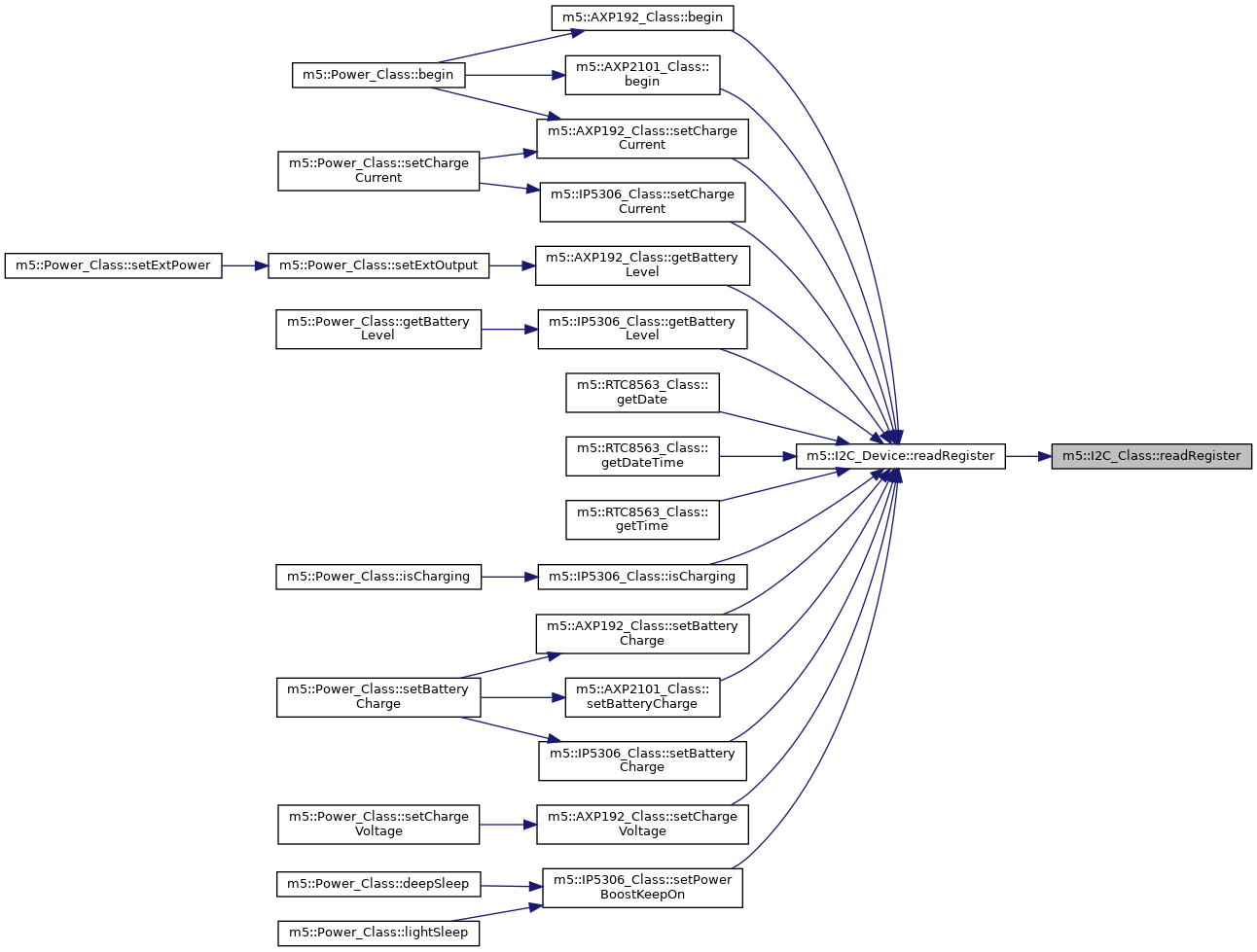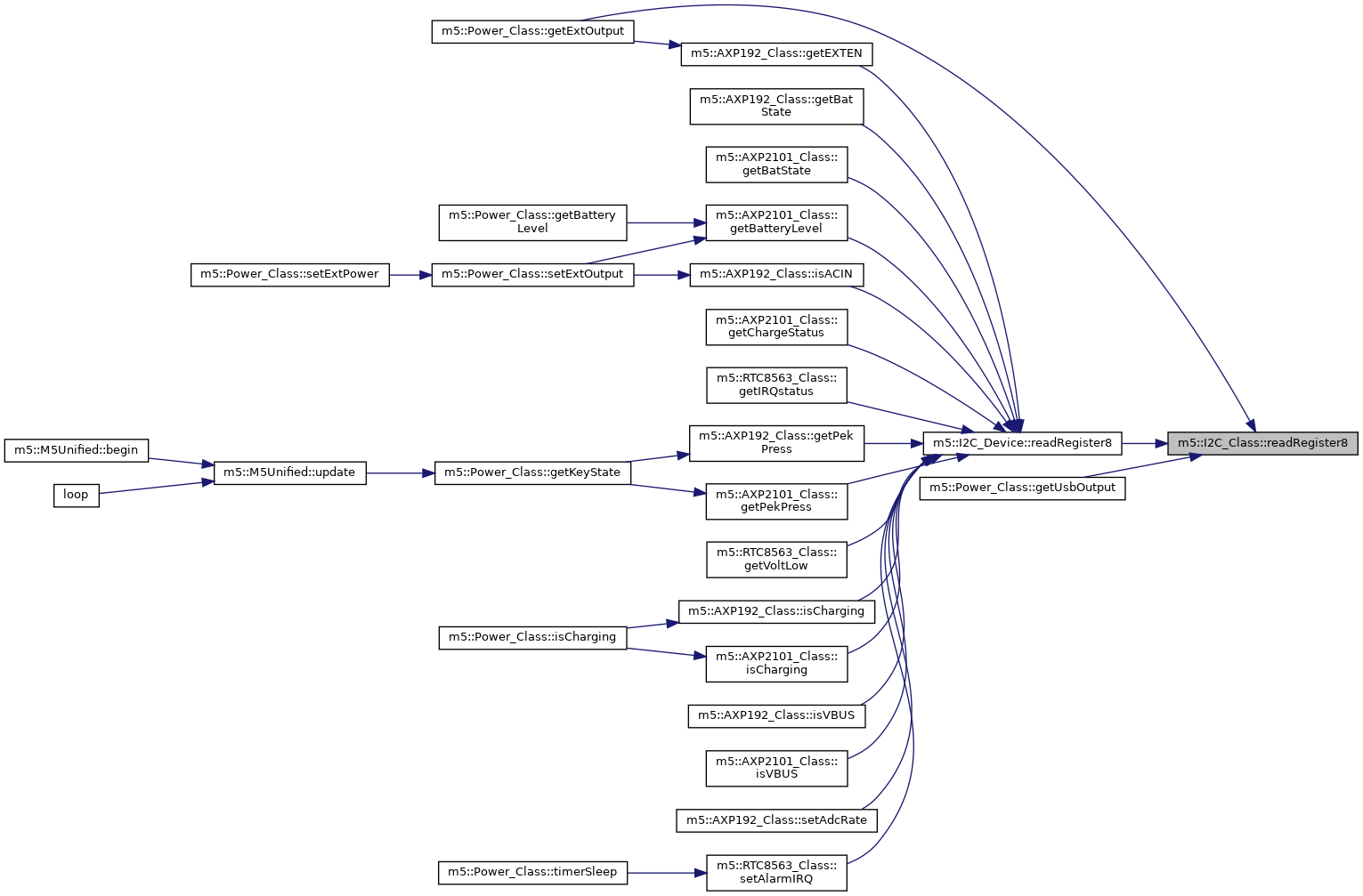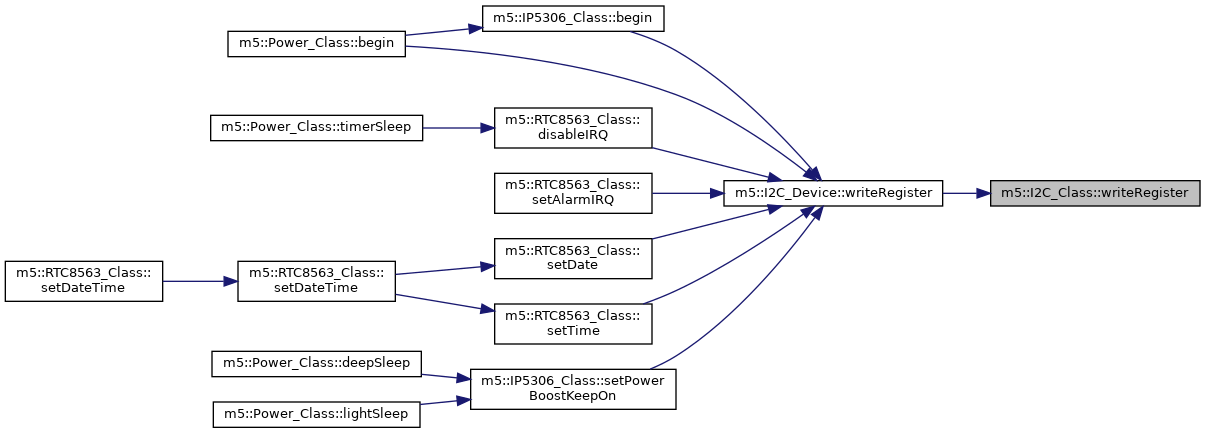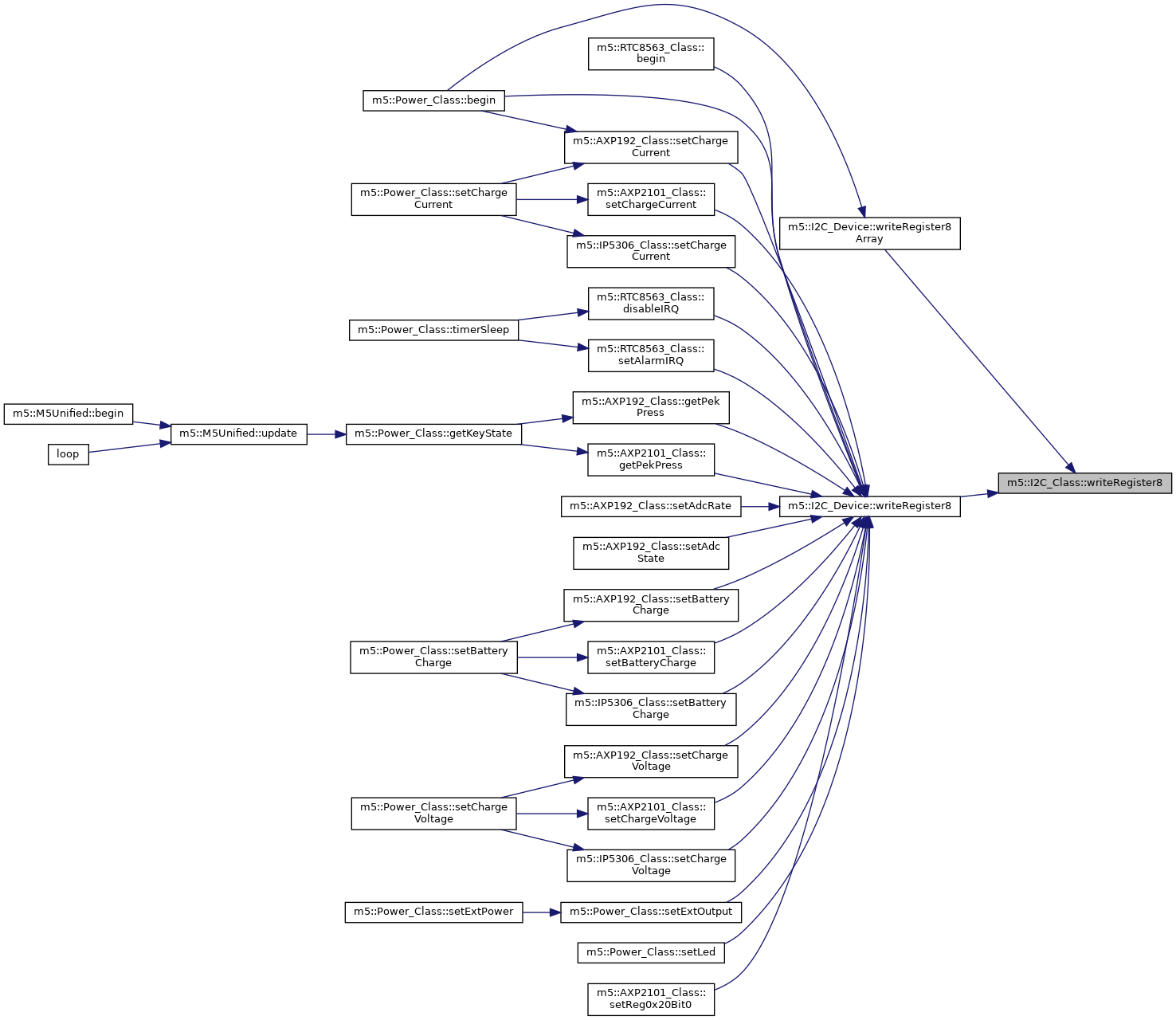#include <I2C_Class.hpp>
Public Member Functions | |
| void | setPort (i2c_port_t port_num, int pin_sda, int pin_scl) |
| bool | begin (i2c_port_t port_num, int pin_sda, int pin_scl) |
| bool | begin (void) |
| bool | release (void) const |
| bool | start (std::uint8_t address, bool read, std::uint32_t freq) const |
| bool | restart (std::uint8_t address, bool read, std::uint32_t freq) const |
| bool | stop (void) const |
| bool | write (std::uint8_t data) const |
| bool | write (const std::uint8_t *data, std::size_t length) const |
| bool | read (std::uint8_t *result, std::size_t length) const |
| bool | writeRegister (std::uint8_t address, std::uint8_t reg, const std::uint8_t *data, std::size_t length, std::uint32_t freq) const |
| bool | readRegister (std::uint8_t address, std::uint8_t reg, std::uint8_t *result, std::size_t length, std::uint32_t freq) const |
| bool | writeRegister8 (std::uint8_t address, std::uint8_t reg, std::uint8_t data, std::uint32_t freq) const |
| std::uint8_t | readRegister8 (std::uint8_t address, std::uint8_t reg, std::uint32_t freq) const |
| bool | bitOn (std::uint8_t address, std::uint8_t reg, std::uint8_t data, std::uint32_t freq) const |
| bool | bitOff (std::uint8_t address, std::uint8_t reg, std::uint8_t data, std::uint32_t freq) const |
| void | scanID (bool *result) const |
| i2c_port_t | getPort (void) const |
| int8_t | getSDA (void) const |
| int8_t | getSCL (void) const |
| bool | isEnabled (void) const |
Detailed Description
Definition at line 19 of file I2C_Class.hpp.
Member Function Documentation
◆ begin() [1/2]
| bool m5::I2C_Class::begin | ( | i2c_port_t | port_num, |
| int | pin_sda, | ||
| int | pin_scl | ||
| ) |
setup and begin I2C peripheral. (No communication is performed.)
- Parameters
-
port_num I2C number. (I2C_NUM_0 or I2C_NUM_1). pin_sda SDA pin number. pin_scl SCL pin number.
- Returns
- success(true) or failed(false).
Definition at line 21 of file I2C_Class.cpp.


◆ begin() [2/2]
| bool m5::I2C_Class::begin | ( | void | ) |
begin I2C peripheral. (No communication is performed.)
- Returns
- success(true) or failed(false).
Definition at line 27 of file I2C_Class.cpp.

◆ bitOff()
| bool m5::I2C_Class::bitOff | ( | std::uint8_t | address, |
| std::uint8_t | reg, | ||
| std::uint8_t | data, | ||
| std::uint32_t | freq | ||
| ) | const |
Write a 1-byte value to the register by bit erase operation. Performs a series of communications from START to STOP.
- Parameters
-
address slave addr. reg register number. data erase bit data.
- Returns
- success(true) or failed(false).
Definition at line 95 of file I2C_Class.cpp.

◆ bitOn()
| bool m5::I2C_Class::bitOn | ( | std::uint8_t | address, |
| std::uint8_t | reg, | ||
| std::uint8_t | data, | ||
| std::uint32_t | freq | ||
| ) | const |
Write a 1-byte value to the register by bit add operation. Performs a series of communications from START to STOP.
- Parameters
-
address slave addr. reg register number. data add bit data.
- Returns
- success(true) or failed(false).
Definition at line 90 of file I2C_Class.cpp.

◆ getPort()
|
inline |
◆ getSCL()
|
inline |
◆ getSDA()
|
inline |
◆ isEnabled()
|
inline |
Definition at line 130 of file I2C_Class.hpp.
◆ read()
| bool m5::I2C_Class::read | ( | std::uint8_t * | result, |
| std::size_t | length | ||
| ) | const |
Receive multiple bytes of data.
- Parameters
-
[out] result read data array. length data array length.
- Returns
- success(true) or failed(false).
Definition at line 62 of file I2C_Class.cpp.

◆ readRegister()
| bool m5::I2C_Class::readRegister | ( | std::uint8_t | address, |
| std::uint8_t | reg, | ||
| std::uint8_t * | result, | ||
| std::size_t | length, | ||
| std::uint32_t | freq | ||
| ) | const |
Read multiple bytes value from the register. Performs a series of communications from START to STOP.
- Parameters
-
address slave addr. reg register number. [out] result read data array. length data array length.
- Returns
- success(true) or failed(false).
Definition at line 75 of file I2C_Class.cpp.

◆ readRegister8()
| std::uint8_t m5::I2C_Class::readRegister8 | ( | std::uint8_t | address, |
| std::uint8_t | reg, | ||
| std::uint32_t | freq | ||
| ) | const |
Read a 1-byte value from the register. Performs a series of communications from START to STOP.
- Parameters
-
address slave addr. reg register number.
- Returns
- read value.
Definition at line 85 of file I2C_Class.cpp.

◆ release()
| bool m5::I2C_Class::release | ( | void | ) | const |
release I2C peripheral.
- Returns
- success(true) or failed(false).
Definition at line 32 of file I2C_Class.cpp.
◆ restart()
| bool m5::I2C_Class::restart | ( | std::uint8_t | address, |
| bool | read, | ||
| std::uint32_t | freq | ||
| ) | const |
Sends the I2C repeated start condition and the address of the slave.
- Parameters
-
address slave addr. read bit of read flag. true=read / false=write.
- Returns
- success(true) or failed(false).
Definition at line 42 of file I2C_Class.cpp.

◆ scanID()
| void m5::I2C_Class::scanID | ( | bool * | result | ) | const |
execute I2C scan. (for 7bit address)
- Parameters
-
[out] result data array needs 120 Bytes.
Definition at line 100 of file I2C_Class.cpp.

◆ setPort()
| void m5::I2C_Class::setPort | ( | i2c_port_t | port_num, |
| int | pin_sda, | ||
| int | pin_scl | ||
| ) |
setup I2C port parameters. (No begin)
- Parameters
-
port_num I2C number. (I2C_NUM_0 or I2C_NUM_1). pin_sda SDA pin number. pin_scl SCL pin number.
Definition at line 13 of file I2C_Class.cpp.

◆ start()
| bool m5::I2C_Class::start | ( | std::uint8_t | address, |
| bool | read, | ||
| std::uint32_t | freq | ||
| ) | const |
Sends the I2C start condition and the address of the slave.
- Parameters
-
address slave addr. read bit of read flag. true=read / false=write.
- Returns
- success(true) or failed(false).
Definition at line 37 of file I2C_Class.cpp.


◆ stop()
| bool m5::I2C_Class::stop | ( | void | ) | const |
Sends the I2C stop condition. If an ACK error occurs, return false.
- Returns
- success(true) or failed(false).
Definition at line 47 of file I2C_Class.cpp.

◆ write() [1/2]
| bool m5::I2C_Class::write | ( | const std::uint8_t * | data, |
| std::size_t | length | ||
| ) | const |
Send multiple bytes of data.
- Parameters
-
[in] data write data array. length data array length.
- Returns
- success(true) or failed(false).
◆ write() [2/2]
| bool m5::I2C_Class::write | ( | std::uint8_t | data | ) | const |
Send 1 byte of data.
- Parameters
-
data write data.
- Returns
- success(true) or failed(false).
Definition at line 52 of file I2C_Class.cpp.
◆ writeRegister()
| bool m5::I2C_Class::writeRegister | ( | std::uint8_t | address, |
| std::uint8_t | reg, | ||
| const std::uint8_t * | data, | ||
| std::size_t | length, | ||
| std::uint32_t | freq | ||
| ) | const |
Write multiple bytes value to the register. Performs a series of communications from START to STOP.
- Parameters
-
address slave addr. reg register number. [in] data write data array. length data array length.
- Returns
- success(true) or failed(false).
Definition at line 67 of file I2C_Class.cpp.

◆ writeRegister8()
| bool m5::I2C_Class::writeRegister8 | ( | std::uint8_t | address, |
| std::uint8_t | reg, | ||
| std::uint8_t | data, | ||
| std::uint32_t | freq | ||
| ) | const |
Write a 1-byte value to the register. Performs a series of communications from START to STOP.
- Parameters
-
address slave addr. reg register number. data write data.
- Returns
- success(true) or failed(false).
Definition at line 80 of file I2C_Class.cpp.

The documentation for this class was generated from the following files:
- src/utility/I2C_Class.hpp
- src/utility/I2C_Class.cpp


